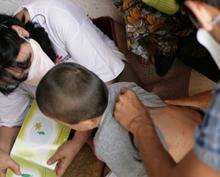MSF Nurse Cindy Gibb discusses her experience in Tajikistan, where MSF has opened a new hospital ward to treat children with tuberculosis and their families.

Tajikistan 2012 © Natasha Sergeeva
An MSF doctor examines a young MDR-TB patient as a mental health counselor reads to him from a TB health education book.

MSF Nurse Cindy Gibb
For the first time, children in Tajikistan with multi drug-resistant tuberculosis (MDR-TB) are receiving treatment for the life-threatening disease. Doctors Without Borders/Médecins Sans Frontières (MSF) has opened a new ward in Machiton hospital, near Tajikistan's capital of Dushanbe, where it plans to treat 60 to 100 children with TB and their family members over the next three months. Cindy Gibb is a nurse from New Zealand working in this groundbreaking treatment program.
It is 8:00 am in Dushanbe, and the summer sun is already hot. I like to start my work day before the other staff comes to the office. Today I need to find time to work on the sputum induction protocol [a procedure used to obtain sputum samples for TB testing from patients who don't spontaneously produce enough]. It’s difficult to diagnose tuberculosis in children bacteriologically, because most kids, especially the younger ones, can’t produce enough sputum for the tests. Pediatric TB is a neglected disease, and there isn’t enough research and development, or any clear-cut advice, on how to treat it in children. Our project is significant—both for MSF and the world—because we are developing guidelines that simply didn't exist before.
My time is divided between the office, the children’s TB hospital in Dushanbe, and the TB hospital in Machiton 17 kilometers [about 10.5 miles] east of Dushanbe where MSF opened a specialized ward for treating children with drug-resistant TB. I also do home visits. Currently, we have 10 patients receiving outpatient care, and the geography of my regular trips ranges from a 20-minute drive to visit 13-year-old Marhabo, whose family lives within the old city walls, to a four-hour drive to Shaatuz and Hamadoni, in the southern Khatlon province. We have two families to visit in that area, where the prevalence of drug-resistant TB is among the highest in the country and access to health care remains unreliable.
At 9:30 am I am in the children’s TB hospital with our doctor. Commonly children are admitted here from as far away as Khatlon Province (in the south) and Sogd (in the north), some for six to eight months of treatment. There are about 30 children with drug-sensitive TB, and five children with drug-resistant TB. My role is to oversee the treatment and how the hospital staff deal with the side effects of the TB drugs.
We’ve been busy recently, with three patients in our program discharged within one week. They will receive the rest of their treatment at home. Yesterday I visited a mother with MDR-TB and her two little boys, who are also sick with TB. Nadira and her family live in a hard-to-reach village north of Dushanbe. It’s just 40 kilometers [about 25 miles] away, but the trip takes about two hours each way due to the poor condition of the road. We always climb the last 20 minutes on foot—a steep uphill struggle best suited to the donkeys who overtake us on the way. But the scenery is amazing; we are surrounded by the almost unbearable beauty of the river valley in summer. We know that the dirt road will be nearly impassable from autumn to spring, and in the winter the villagers will be cut off from the highway by snowfalls.
When a child is discharged from the TB hospital, I have to prepare everything for their smooth passage: I make sure that the drugs are available, that the nurse at the local health post is trained to work on the case, and that there is transport available in case the family needs to travel to the nearest clinic. Usually, it’s the local community nurse who observes the daily intake of drugs and gives the injections, but in the case of Nadira’s family, it’s a distant relative who has volunteered to be trained. She has no formal health training but neither does anyone else in their village. We provide "enablers"—such as transport and mobile phone credit—to the families and care providers performing home visits. Patients also get weekly food parcels containing basic products, such as tinned meat, fish, milk, and vegetables.
Next week I’m going to visit the family of Nadira’s sister, Gulnara, another part of the heartbreaking mosaic of "family TB." Both Gulnara and her two children, Hassan and Dilnoza, are sick with MDR-TB. Identifying close family contacts is an important part of the project, given the strong family ties and the tradition of extended families living together in one household.
Lunch in the office is the time when the team comes together and discusses both work and non-work–related issues. I also have my regular hour of Tajik language lessons. I discovered pretty soon after I arrived that knowing how to say even the most basic things in Tajik opens up many doors—and hearts—in my professional and personal relationships.
The doctor and I, along with our translators and a driver, are going to drive for three hours along the picturesque—if bumpy—mountainous road before night falls, then we will stay overnight in Shaartuz. The following day we will see our patient and family and check on the local health post and medical staff.
In the car, I eventually have some time to work on the policy on sputum induction in children with TB. The rest of the trip we practice our Tajik. My work requires a lot of travel, but I feel privileged to do this job and to see all the little corners of Tajikistan. The project is growing, we will have more and more patients receiving outpatient care, and I am looking forward to finding a Tajik staff nurse to help me.




